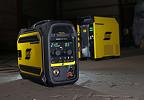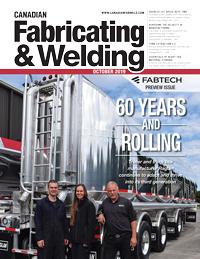Editor
- FMA
- The Fabricator
- FABTECH
- Canadian Metalworking
Fume extraction 4.0
Are you doing everything you can with your technology to improve fume management?
- By Rob Colman
- Updated October 18, 2019
- October 28, 2019
- Article
- Welding
Many of the newer machines you’ll see on a shop floor today have the capacity to provide users with a tremendous amount of data if they are armed with the proper software to view it. The question this always raises is, What use is all that data to production? The short answer is, If it is used correctly, it can increase productivity. Data collected from fume extraction equipment gives manufacturers the ability to monitor and improve their fume management profile, which also increases productivity.
Technologies have been incorporated into some welding machines that are helping manufacturers reach their goals of generating less fume right at the arc site. This is helping shop owners to meet stringent exposure limits. Some provincial bodies are demanding as much as a tenfold reduction in threshold limit values for respirable manganese, for instance.
But fume is still generated, and it’s necessary to limit a welder’s exposure to the plume created by weld fume. Fume extraction systems are an important part of limiting that exposure, and with the growing sophistication of monitoring technologies in these systems – the sort of feedback we associate with IIoT or Industry 4.0 capabilities – it’s becoming easier to keep these systems running efficiently and effectively.
Fume Extraction Feedback
Many fume extraction and dust collector manufacturers have seen the value sensor technology can bring to the way they serve fabricators. If they can tell a customer when a filter needs replacing or a system isn’t drawing the proper amount of air, it saves the fabricator time and money. It also ensures that fume extraction is occurring at the rate the company expects to meet its fume reduction targets.
“While dust collection systems are necessary to create a clean and safe workspace, maintaining and operating them is not always a popular task or expense for manufacturers,” said Travis Haynam, director of IoT development at Nederman. “Using IIoT, we can remove some of this burden and give the shop somebody else they can rely on to track and monitor the dust collector, while they focus more on their core business that pays the bills. If maintenance is required, we alert them and can give them information they can act on about what might be going on and help troubleshoot it over the phone.”
A responsive or intelligent extraction/dust collection system might lead to less frequent maintenance, whereas previously maintenance was performed on a regular schedule when it might not have been required.
Machine Knowledge
Alex Ensminger, software engineer at RoboVent, sees fume extraction monitoring as a way of taking away the “black box” feel of the equipment.
“We’ve gotten interesting feedback from customers who say they mainly want to be sure their machines are operational and that if anything goes wrong, we can respond and fix them promptly,” said Ensminger. “But equally, having the visibility to see what’s going on with the machines in real time and also historically – being able to see what the pattern has been of equipment usage – has been a powerful thing for them. They understand the machines better than they once did. Having that data flow is a real democratization of information from the machine. They understand better by looking at the dashboards we provide them with what it means to say that their machinery is running smoothly, or what it looks like when there’s a problem.”
Timely Maintenance
Wade Wessels, global director, connected solutions strategy at Donaldson Company, offers two examples of how monitoring systems can have an impact on operations.
“We have one customer that processes very sticky material, so hoppers becoming plugged by this sticky material was a way of life for them. But they had no way of knowing when the plug was going to happen so that they could respond to the problem,” Wessels said. “Because of this, [the sticky material] would fill up into the machine, and suddenly they would notice their filtration system wasn’t working properly. Having to clean out the hopper at that point is a messy business that can take the machine offline for two hours. We put a sensor on the collector that detects the second dust stops flowing. That alert goes directly to the maintenance leader who can react immediately. Now the correction takes 15 minutes, and no one needs to get dirty.
“A second example is a customer that was experiencing short filter life and thought maybe that was just the nature of the work they were doing,” Wessels continued. “We were able to observe the ongoing performance of the filtration unit and could see that the filters should have been lasting much longer. The machine wasn’t getting the compressed air it needed. The problem was, in the morning, before all the other machines in the shop were turned on, the compressed air level seemed fine. However, when other machines started drawing from the same source, the compressor couldn’t keep up with demand. Once that issue was sorted, filter life went from less than two months up to a year.”
These feedback systems, therefore, can help diagnose any number of issues with airflow and how it affects a shop. For the shop, it’s simply a matter of deciding what level of monitoring it wants.
Real-time Responsive Tech
Haynam noted that examples like this are really just the tip of the iceberg with respect to what these feedback systems can offer. Ultimately, the idea is that shops can have self-regulating “smart” systems that can react to real-time situations on the shop floor.
“We are doing work with some manufacturers already in this respect,” said Haynam. “Companies that make other smart machinery have relevant information that will affect the collector, and we have relevant information for maintaining and operating their equipment as well.”
Haynam said they are not quite there yet, but the ultimate goal of this development is to have equipment that adjusts performance based on what is happening on the shop floor.
“For instance, in terms of ambient weld fume systems, you could have an emissions monitor that detects contaminant levels or uses predictive modelling on when to ramp up fume extraction during a given operational cycle of a shop,” Haynam said. “Or it could take actual operational outputs from a welder or a plasma cutting machine. On some machines, you really only need fume extraction when piercing and cutting. This responsive type of technology could save energy, extend the life of filters, and reduce wear and tear on systems.”
Haynam believes that this kind of technology is scalable and can be a leveller for smaller shops that may not have the resources to focus on optimizing operations.
“With this kind of monitoring, smaller shops can keep their resources focused on production in a way they couldn’t before,” he said.
Ensminger also sees value in linking all of this machine data with what we might refer to as “soft” data – employee retention and absenteeism, for instance.
“How does the air quality and the running of your filtration system connect to your employee retention rates or how often people go home sick, for instance?” said Ensminger. “That’s an exciting further consideration – this information may not be systems-based, but there is key data there with respect to how well a shop functions. What will be interesting is when that type of data is merged and considered together.”
Wessels pointed out that shops are becoming so technologically advanced, anything that saves skilled resources time will inevitably be an advantage.
At the same time, the shops benefit from more consistently clean air, and fume management programs meet the targets suggested by the rate capacity of the equipment they have invested in.
Editor Robert Colman can be reached at rcolman@canadianfabweld.com.
Image courtesy of Nederman.
Donaldson Co. Inc., www.donaldson.com
Nederman, www.nederman.com
RoboVent, www.robovent.com
About the Author

Rob Colman
1154 Warden Avenue
Toronto, M1R 0A1 Canada
905-235-0471
Robert Colman has worked as a writer and editor for more than 25 years, covering the needs of a variety of trades. He has been dedicated to the metalworking industry for the past 13 years, serving as editor for Metalworking Production & Purchasing (MP&P) and, since January 2016, the editor of Canadian Fabricating & Welding. He graduated with a B.A. degree from McGill University and a Master’s degree from UBC.
subscribe now


Keep up to date with the latest news, events, and technology for all things metal from our pair of monthly magazines written specifically for Canadian manufacturers!
Start Your Free Subscription- Trending Articles
CWB Group launches full-cycle assessment and training program

Achieving success with mechanized plasma cutting

3D laser tube cutting system available in 3, 4, or 5 kW

Brushless copper tubing cutter adjusts to ODs up to 2-1/8 in.

Welding system features four advanced MIG/MAG WeldModes

- Industry Events
MME Winnipeg
- April 30, 2024
- Winnipeg, ON Canada
CTMA Economic Uncertainty: Helping You Navigate Windsor Seminar
- April 30, 2024
- Windsor, ON Canada
CTMA Economic Uncertainty: Helping You Navigate Kitchener Seminar
- May 2, 2024
- Kitchener, ON Canada
Automate 2024
- May 6 - 9, 2024
- Chicago, IL
ANCA Open House
- May 7 - 8, 2024
- Wixom, MI
















